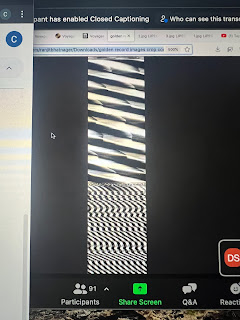clarawrenDESMA9
Clara Wren - Event 2 - Cosmological Elements: Space & Art #2
I attended the second zoom meeting of the three series of the Cosmological Elements, Space and Art, on April 28, 2023, at 10:00a.m. This event had a numerous number of guests that explained their inventions, productions, and artworks. I found this event to be very fascinating and interesting. There were several ideas I had never heard of or thought of before. It was a very educational and eye-opening experience to see all of these different products people have come up with just based on their own research and findings.
Although there were several speakers, I found Ranjit Bhatnagar’s work and Sebastian Alexander Neitsch work to be the most intriguing to me. These are the two pieces of art that I am going to primarily focus on.
Starting with Ranjit Bhatnagar, he was able to make a textile piece of work that has to do with space. As he mentioned, the Voyager spacecraft was sent into space in 1977 to study the outer planets. They are still operating out there, fifty years later. Placed on the spacecraft was a golden record that contained sounds and images. He was able to take the sound and produce it into a long piece of art that actually looks quite beautiful. The sound itself sounds very static, with different fluctuations of high pitch sounds and low pitch sounds. It was put into photoshop and showed great distortion. This type of work showed lots of mathematics and chemistry. I thought that this was so amazing how a piece of artwork was created from a sound from the Voyager. The idea was so creative and interesting.
Zoom Live Event

Physical Artwork Displayed
Ranjit, and Ranjit. Moonmilk, 10 July 2018, https://moonmilk.com/2018/07/10/the-tapestry-of-the-search-for-extraterrestrial-intelligence/.
Next, Sebastian Alexander Neitsch worked in a building that was built the same year as the first satellite. In his research, he realized the American Government was trying to find a way to see what is actually going around Earth, but they did not have the technology to accurately track the satellite. Sebastian Neitsch was manually checking the skies and writing down the orbital data that he observed. He collected two or three line data sets. The trackable data was made into a beautiful piece of art by connecting the lines. I was shocked by this piece of art because it looks really cool, and came from data he observed and researched on his own.
Zoom Live Event
There were so many other amazing pieces that were mentioned in this live event, however, these were the two that interested me and fascinated me the most. I felt it was incredible creativity and work.
References:
“Aboutحول.” FESTIVAL X, https://festivalx.ae/.
Bhatnagar, Ranjit. Zoom.
Neitsch, Sebastian. Zoom.
“Two-Line Element Set.” Wikipedia, Wikimedia Foundation, 12 Jan. 2023, https://en.wikipedia.org/wiki/Two-line_element_set.
28, Brian Hiles on February, and Justin Hall on October 7. Moonmilk, https://moonmilk.com/about/.
Email Confirmation




Comments
Post a Comment